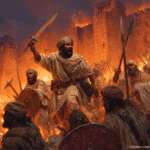
In 1121 CE, far to the western edge of the Islamic world, a new flame of religious fervor and political upheaval was kindled in the mountains of present-day Morocco. It was here, in the rugged and often fiercely independent Berber lands of the High Atlas, that a man named Abdallah ibn Tumart declared himself the Mahdi, a messianic figure who would purify Islam and unite believers under a stricter vision of faith. This moment marked the birth of the Almohad movement, a revolution that would reshape North Africa and ripple across Iberia.
The Cracks in Almoravid Rule
For decades before 1121, the Almoravid dynasty had ruled over much of Northwest Africa and al-Andalus (Muslim Spain), enforcing a rigid form of Islamic orthodoxy. This dynastic order emerged out of the Sanhaja Berber tribes of the desert, led by reformist warriors who had swept northward with fire and zeal. They built a powerful empire, taking control of Marrakesh as their capital and later dominating Muslim Spain. Their power was unquestioned, but time had eroded their energy. By the early twelfth century, their rule was increasingly viewed as harsh, formalistic, and out of touch with local traditions, particularly among other Berber groups who bristled at their authority.
Into this volatile environment stepped Abdullah ibn Tumart.
Ibn Tumart: The Self-Proclaimed Mahdi
Ibn Tumart was no ordinary figure. Born into the Masmuda Berber tribes of the Atlas, he was said to have traveled eastward in search of knowledge. In Baghdad, he absorbed theological training and returned with the ideas of reformist theologians, blending them with his own fierce temperament. When he reappeared in Morocco around 1120, he began to preach against what he saw as the decadence and rigidity of the Almoravids, accusing them of corruption, innovation, and deviation from tawḥīd (God’s unity).

In 1121, he proclaimed himself the Mahdi – the divinely guided one who, in Islamic eschatological expectation, would appear to set right the affairs of the faithful. Such a claim was audacious, even dangerous, but it captured the imagination of many Masmuda Berbers weary of Almoravid dominance. To them, Ibn Tumart was not merely a preacher; he was a savior and revolutionary.
The Birth of the Almohad Movement
Ibn Tumart’s followers became known as al-Muwaḥḥidūn, “the upholders of God’s unity” – a name anglicized as the Almohads. From their mountain base at Tinmal, they began carving out a new order, bound not just by politics but by a strict, moralistic vision of piety. Ibn Tumart’s declaration as Mahdi gave the movement a messianic edge. Obedience was both a political act and a sacred duty.
The Almoravids and their brand of reformist Islam had once been feared for their zeal; now they faced rivals even more uncompromising. Ibn Tumart and his movement launched a revolution that demanded not only political submission but also moral purification of society.
The Keeper of Morals: Enforcing Piety
Central to this revolutionary movement was the creation of an administrative structure aimed at enforcing religious purity. Among the most striking innovations was the office of the mizwar, or “keeper of morals.” This official had sweeping powers to act as the enforcer of piety.
Alcohol, viewed as a corruption of the soul, was outlawed: drinkers were punished severely. Music, with its capacity to distract hearts from God, was targeted as well. The mizwar was tasked with smashing musical instruments and rooting out practices deemed frivolous or sinful. In this new society, laughter, leisure, and indulgence were suspect; absolute devotion and strict discipline were the demand. Where the Almoravids had been stern, the Almohads aimed to be unyielding.
Revolution in the Atlas
The rebellion ignited in the mountains, and what might have seemed a fringe movement to the great Almoravid rulers quickly spiraled into an existential threat. The Masmuda tribes, inspired by Ibn Tumart’s charisma and religious fire, provided the manpower for his cause. His teachings, infused with apocalyptic urgency, united traditionally fractious Berbers under shared conviction.
By 1121, the Almohad movement had consolidated enough strength to openly challenge Almoravid authority. Marrakesh might still glitter as the capital of the empire, but a storm was gathering in the Atlas – one powered not by gold or armies, but by faith and belief in the coming of the Mahdi.

Though Ibn Tumart himself would not live to see the ultimate triumph of the Almohads, his proclamation in 1121 had set into motion a revolution. After his death in 1130, his followers carried the torch under Abd al-Mu’min, a brilliant military strategist and statesman who transformed a religious brotherhood into an expanding state.
Abd al-Mu’min and the Conquest of Marrakesh
Abd al-Mu’min reorganized the Almohads into a disciplined force, expanding out of the Atlas Mountains and pushing steadily toward the Almoravid heartland. The decisive blow came in 1147, when Almohad armies stormed Marrakesh, the jewel of the Almoravid realm. The fall of Marrakesh marked not only the collapse of the Almoravid dynasty but the symbolic transfer of leadership over the Maghreb to the Almohads.
With ruthless efficiency, Abd al-Mu’min consolidated power, annihilating remaining Almoravid resistance and eliminating rival factions. Marrakesh, once a bustling stronghold of the Almoravids with their distinctive Maliki legalist culture, now became the new center of Almohad authority.
Expansion Across North Africa
After securing Marrakesh, the Almohads projected power eastward. By the mid-12th century, Abd al-Mu’min extended Almohad dominion over Tunisia, Algeria, and Libya, uniting the Maghreb from the Atlantic to Tripolitania. This scale of unification was unprecedented in the region’s history, rivaling the early Islamic conquests centuries before.
The Almohads distinguished themselves with an imperial organization that blended austere religious leadership with carefully managed tribal alliances. Abd al-Mu’min also built a dynastic monarchy, ensuring that his descendants would control the caliphate – a contrast to the more loosely organized Almoravid predecessors.
Crossing the Straits: The Almohads in Al-Andalus
The deterioration of Almoravid authority in Iberia opened the door for the Almohads to inherit their role as defenders of al-Andalus against the Christian Reconquista. By the 1150s, Almohad armies had crossed into Spain, taking over Andalusi cities once ruled by the Almoravids. Córdoba, Seville, Granada, and Valencia gradually came under their sway.
The Almohads projected themselves as the legitimate champions of Islam in Iberia, rallying resistance against the Christian kingdoms of León, Castile, Aragón, and Portugal. They established Seville as a political and cultural center, leaving an enduring architectural legacy in monuments such as the Giralda, originally the minaret of the city’s great mosque.

The Zenith and Legacy of the Almohad Empire
By the late 12th century, the Almohads commanded an empire stretching from the Atlantic shores of Morocco to the olive groves of Tunisia, and from the foothills of the Sahara to the Guadalquivir valley in Spain. Their reformist zeal and military organization had crushed the once-mighty Almoravid Empire and restored Maghrebi and Andalusi unity – at least temporarily.
They reached their peak under rulers like Abu Yaqub Yusuf and Yaqub al-Mansur, who defeated Christian forces at the Battle of Alarcos in 1195. Yet this triumph masked deeper weaknesses: internal divisions, overextension, and growing revolts at the empire’s edges. Their crushing defeat at Las Navas de Tolosa in 1212 at the hands of a united Christian coalition marked the turning point from which the Almohad Caliphate would never recover.
Nevertheless, the Almohad legacy reshaped the western Islamic world. They reinforced Marrakesh as a key imperial city, left striking architectural achievements, and deeply influenced Andalusi thought and governance. Their rise from a mountain reform movement in 1121 to imperial masters of North Africa and al-Andalus remains one of the most compelling stories of medieval Islamic history.




